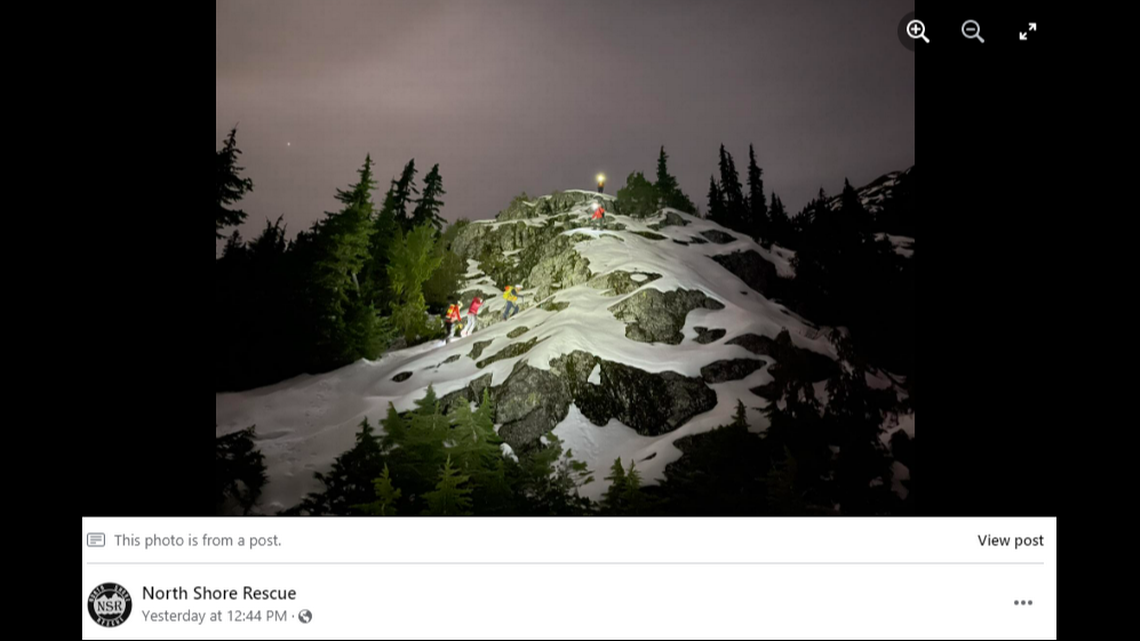Hiking group realizes one member is missing in Canada. Then 9-hour search ensues

After connecting online, a group of hikers met up in person for a hike on Mount Seymour in Canada. But when the group reached the end of their hike, they realized they were missing one person.
The group called for help around 6:30 p.m. on Nov. 26, according to a Nov. 27 news release from the Royal Canadian Mounted Police.
When police arrived, they learned that the missing hiker’s phone was dead — so they relied on “traditional foot searchers and call-outs.” Because the sun had set, temperatures were falling and there were “treacherous hiking conditions,” and North Shore Rescue assisted in the search, officials said.
Rescuers learned the group had watched the sunset from Pump Peak, and the missing hiker had left about 15 minutes before the rest of the group, North Shore Rescue said in a Facebook post. Officials suspected the hiker had likely gone off trail in one of two places, but their searchers were unsuccessful.
Then rescuers heard “an extremely faint sound” and discovered “a single set of fresh bootprints” leading away from the trail, the post said. As rescuers followed the bootprints “down extremely complex terrain,” the sounds got louder and louder.
A thermal drone pinpointed the hiker’s location, and after more than nine hours, the team found the missing hiker, warmed him up, gave him food and water, and tended to his injuries, according to North Shore Rescue.
Rescuers said the hiker “suffered minor injuries from the fall.”
Mount Seymour “is extremely rugged,” and weather can change quickly in the area, according to BC Parks. The park offers 14 hiking trails ranging in length and difficulty.
As of 9 a.m. on Monday, Nov. 27, the temperature on the mountain was about 36 degrees, and there had been less than an inch of snow at the mountaintop, according to the Mount Seymour website.
The mountain is about 12 miles northeast of Vancouver.
What to do if you get lost while hiking
If you think you’re getting lost, experts say it’s best to stop where you are and not panic. You should go over how you got to that point and if you’re able to see any landmarks around.
“Do not move at all until you have a specific reason to take a step,” officials with the U.S. Forest Service said.
You should come up with a plan but stay put unless you are “very, very confident in the route.”
There are steps hikers can take to avoid getting lost and be better prepared for the unexpected:
Have more than enough food and water with you.
Take a compass that you know how to use, or have a GPS device on hand.
Don’t rely solely on your cellphone. It probably won’t work because of a lack of signal or a depleted battery.
Study the terrain and your route, and you should know how you’ll return.
Have the right clothing. Sturdy hiking boots and layers can help you be prepared for rapidly changing weather.
Pack a blanket, flashlight and matches.
Check with a local ranger for special warnings. They can tell you about “fires in the area, bear sightings, flooding, trail or road closures.”
Hiker with frozen feet calls 911 near mountaintop — but rescuers couldn’t call back
Family of 5 hiking to summit gets trapped in snow without food, Colorado cops say
36-year-old avid ice climber dies after fall near Montana waterfall, rescuers say


